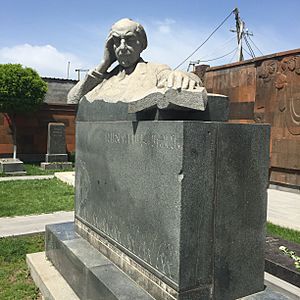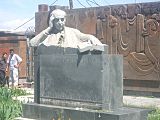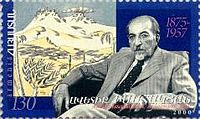Avetik Isahakyan facts for kids
Quick facts for kids
Avetik Isahakyan
Ավետիք Իսահակյան |
|
|---|---|
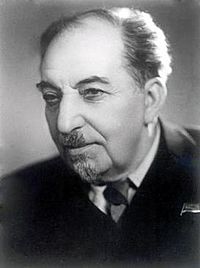 |
|
| Born | October 30, 1875 Alexandropol, Erivan Governorate, Russian Empire (now, Gyumri, Armenia) |
| Died | October 17, 1957 (aged 81) Yerevan, Soviet Armenia |
| Resting place | Komitas Pantheon |
| Occupation | Poet, Novelist |
| Language | Armenian |
| Nationality | Armenian |
| Alma mater | Gevorkian Theological Seminary Leipzig University |
| Spouse | Sophia Kocharian |
| Signature | |
Avetik Isahakyan (Armenian: Ավետիք Սահակ Իսահակյան; born October 30, 1875 – died October 17, 1957) was a very important Armenian poet, writer, and public figure. He is known for his beautiful and emotional poems.
Contents
Biography
Early Life and Education
Avetik Isahakyan was born in a city called Alexandropol (now Gyumri) in 1875. He went to school at the Kevorkian seminary in Echmiadzin. Later, he studied philosophy and anthropology at the University of Leipzig in Germany.
He started his writing career and became involved in politics when he was young. When he came back from Leipzig in 1895, he joined the new Armenian Revolutionary Federation in Alexandropol. He helped armed groups and sent money to Western Armenia. Because of his activities, he was arrested in 1896 and spent a year in prison in Yerevan.
Life Abroad and Return
After being released, Isahakyan traveled abroad again. He attended classes on Literature and History of Philosophy at the University of Zurich. He returned to his home country in 1902 and then moved to Tiflis.
In 1908, he was arrested again along with many other Armenian thinkers. He spent six months in prison in Tiflis before being set free on bail. It became difficult for him to stay in the Caucasus region, so he moved away in 1911.
Isahakyan did not trust the promises made by the government of the Young Turks. These promises were about giving Western Armenia self-rule. He believed that the danger of Panturkism (which he thought aimed to destroy Armenians) could be stopped by Turkey's ally, Germany. So, Isahakyan went to Berlin. There, he worked with German thinkers in a group called the German-Armenian movement. He helped edit their magazine "Mesrob" and co-founded the German–Armenian Society.
World War I and Armenian Genocide
When World War I started, terrible massacres happened. These events confirmed Isahakyan's fears about the Young Turks government. After the war and the Armenian genocide, Isahakyan wrote about the sad fate of Armenians. He also wrote about their brave fight for freedom. He spoke out about the genocide, which happened mostly between 1915 and 1922, in his book "The White Book".
During this time, Isahakyan shared his ideas through articles. He wrote about the Armenian cause, the idea of reuniting Armenia, and bringing back the Armenian government. The sad images of the massacres often appeared in his poems. Some of these poems include "Snow has Covered Everything...", "To Armenia...", and "Here Comes Spring Again".
Later Life and Recognition
In 1926, a Russian writer named Korney Chukovsky met Isahakyan. Chukovsky wrote that Isahakyan was a very kind and humble person. He was so famous that even a barber and a shoeshine man knew his poems by heart.
Isahakyan went abroad again in 1930 and lived in Paris. But he came back to the Armenian SSR for good in 1936. There, he became a member of the Academy of Sciences of the Armenian SSR in 1943. He also became the president of the Writers Union of the Armenian SSR in 1944.
He received the Stalin State Prize in 1946. He was also a member of the Soviet Committee for Protection of Peace. He served as a deputy in the Armenian SSR's Supreme Soviets several times. He was given the Order of Lenin twice and other awards.
Isahakyan was a thoughtful person. He noticed that a famous satirist from Gyumri, Poloz Mukuch, did not have a tombstone twenty years after he died. So, Isahakyan ordered one for him. One side of the tombstone read, "To Poloz Mukuch (Mkrtich Ghazarosi Melqonyan)." The other side said, "A memento from the poet Avetik Isahakyan."
Avetik Isahakyan passed away in Yerevan in 1957. He is buried at the Komitas Pantheon, a special burial place in the center of Yerevan.
Works
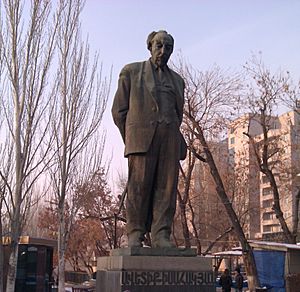
Early Poems and Themes
After being released from prison in 1897, Isahakyan published his first collection of poems called "Songs and Wounds". His poems were very emotional and musical, which made him popular right away. Many of his best works show sadness and deep thoughts about human destiny and life's unfairness. His writings are also full of love for his homeland and its people.
Between 1899 and 1906, he wrote "The Songs of Haiduks". This collection of poems was the first in classical Armenian poetry to be about the Armenian fight for freedom.
Unfinished Novel and Return to Armenia
"Usta Karo" was an unfinished novel by Isahakyan. It was a symbolic story about Armenian politics and the Armenian cause in the late 1800s and early 1900s. He worked on it throughout his life. He used to say, "Usta Karo will be done on the day when the Armenian cause is resolved." Isahakyan felt deep pain about Armenia being divided. He always believed that Armenians would one day return to their native lands.
Isahakyan returned to Soviet Armenia in 1926. There, he published a new collection of poems and stories, like "A Pipe of Patience" (1928). From 1930 to 1936, he lived abroad and supported the Soviet Union. He then moved back to Armenia permanently and continued his important public work. Some of his works from this time include "Our historians and Our Minstrels" (1939), "To my Motherland" (1940), "Armenian Literature" (1942), and "Sasna Mher" (1937).
Famous Works and Style
His poems often speak of love and sorrow. His most famous work is "Abu-Lala Mahari" (written between 1909 and 1911). Other well-known works include "Songs and Novels" and "The Mother's Heart". Isahakyan was a romantic writer. He is especially known for his poem "On the Bridge of Realto," which he wrote for his first love.
During Second World War (1941–1945), he wrote patriotic poems. These include "Martial Call" (1941), "My Heart is at the Mountains' Top" (1941), "To the Undying Memory of S.G. Zakyan" (1942), and "The Day of the Great Victory" (1945).
Isahakyan's writings are full of humanism, which means a great respect for human dignity. His work is deeply connected to the history and culture of the Armenian people. It also uses the best traditions of Russian and world literature. The Russian poet Alexander Blok called him "a first class poet, fresh and simple."
Isahakyan's works have been translated into many languages. His poems have also been used as lyrics for new songs.
Legacy
Avetik Isahakyan is remembered in many ways.
- One of the busiest streets in Yerevan is named after him. It stretches for 1.1 kilometers in the city center.
- A bronze and granite statue of Avetik Isahakyan was opened in 1965 in Yerevan's Circular Park. It was created by sculptor Sargis Baghdasaryan and architect Liparit Sadoyan.
- The first public library in Yerevan, opened in 1935, was named after Avetik Isahakyan in 1955. This was to celebrate his 80th birthday.
- Isahakyan's picture appears on the Armenian 10,000-dram banknote.
- He was also featured on a 2000 Armenian postage stamp and a 1975 U.S.S.R. postage stamp.
-
Avetik Isahakyan on a 1975 U.S.S.R. postage stamp.
-
Avetik Isahakyan on a 2000 Armenian postage stamp.
-
Avetik Isahakyan on an Armenian 10,000-dram banknote.
See also
- Statue of Avetik Isahakyan


